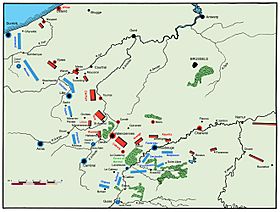Siege of Landrecies (1794) facts for kids
Quick facts for kids Siege of Landrecies (1794) |
|||||||
|---|---|---|---|---|---|---|---|
| Part of the Low Countries theatre of the War of the First Coalition | |||||||
 Positions of the armies in early April 1794 First Coalition forces French Republic forces |
|||||||
|
|||||||
| Belligerents | |||||||
| First Coalition: |
|||||||
| Commanders and leaders | |||||||
| Strength | |||||||
| 7,000 | 20,000 | ||||||
| Casualties and losses | |||||||
| 2,000 | 500 | ||||||
The Siege of Landrecies (April 17–30, 1794) was an important military event during a war called the War of the First Coalition. It happened in the spring of 1794 in the Low Countries. The Dutch army, led by the Hereditary Prince of Orange, attacked the French fortress of Landrecies. Austrian soldiers also helped the Dutch. The French troops inside the fortress were led by General Henri Victor Roulland. The French fortress surrendered on April 30, 1794.
Contents
Why Landrecies Was Important
In early April 1794, military leaders from the Coalition (a group of countries fighting France) met in The Hague. They decided that capturing the fortress of Landrecies was a very important goal. The Dutch army, which had not been in action for a while, was given this task.
Landrecies had a long history of being fought over. It was originally part of the Habsburg Netherlands. In 1543, the French took it, but it was later returned. In 1655, the French captured it again after a short siege. It then became part of France.
A famous military engineer named Sébastien Le Prestre de Vauban built strong defenses around Landrecies. These defenses made it very hard to capture. The fortress successfully defended itself in earlier wars, like the Franco-Dutch War. It even held out against Prince Eugene in 1712.
Starting the Attack
The Coalition armies were led by the Austrian emperor, Francis II. They were fighting against the French armies, led by General Jean-Charles Pichegru. The French had started their spring attacks in March 1794. But by early April, the Coalition forces in Flanders were ready to begin their own attack.
On April 16, 1794, Emperor Francis reviewed the combined British, Austrian, and Dutch armies. This happened near Cateau-Cambrésis. The very next day, April 17, the Allies launched a huge attack across a wide area. The Dutch army reached the outer defenses of the fortress of Cambrai that evening. Other Coalition groups captured villages like Catillon-sur-Sambre, which was close to Landrecies.
The Siege Begins
The Dutch army had about 16,000 soldiers. They were joined by 4,000 Austrian soldiers and artillery (big guns). These Austrian forces were led by Major-General Count Baillet de Latour and Major-General Johann Kollowrat.
On April 18, 1794, this combined force marched from their camp near Cambrai towards Landrecies. On April 19, they got ready for the attack. Then, on April 20, they launched a three-part attack on the fortress.
Two groups of soldiers marched through the Forêt de Mormal forest towards the Sambre river. They captured villages like Hapegarde and Etoguis. They also took a strong camp called Preux-au-Bois, which was close enough for their cannons to reach the fortress. The Swiss Guards and the Hesse-Darmstadt brigade fought very bravely in this battle.
The middle group of soldiers quickly took over the outer defenses of the fortress. The French soldiers inside Landrecies were forced to retreat behind the main walls. The Dutch army lost 23 officers and 358 other soldiers in this first fight.
Building Defenses and Facing Challenges
After the first attack, the Dutch army immediately began to surround the fortress. They started building a line of defenses that stretched to the Sambre river. This cut off Landrecies from any land access. They also set up two large gun batteries near the town's main entrances.
The Hereditary Prince set up his headquarters at the chateau of Bousies. Austrian soldiers, including Hungarians, Serbs, and Croats, built a camp in the Mormal forest. These soldiers were meant to dig the trenches for the siege.
Progress was slow after April 20. The Dutch army had to send many soldiers (8,000 on April 22 alone) to help other Coalition forces. These forces were busy stopping French attempts to rescue the fortress. The Coalition successfully defeated these French attempts in battles like Villers-en-Cauchies and Beaumont-en-Cambresis. French soldiers from the fortress also made surprise attacks, which slowed down the siege preparations.
The Bombardment
On April 26, William V, the father of the Hereditary Prince, visited the siege camp. He was the Captain-General of the Dutch Army. During his visit, his son ordered a demonstration of the artillery, even though not all the guns were ready. The stadtholder was so impressed that he decided to stay and watch the rest of the bombardment.
The gun positions were finally ready on April 28. There were eleven batteries with a total of 48 cannons. These cannons ranged from small 3-pounders to large 24-pounders. They also had 18 siege mortars, which fired very heavy bombs.
The bombardment started on April 28 and lasted for three days. The cannons and mortars fired about 14,000 projectiles. The fortress and town were severely damaged. Almost every house was hit. The front of the attack area was completely destroyed. About 2,000 people, both soldiers and civilians, were killed. One mortar bomb tragically killed a woman and her eight children.
Despite the danger, the civilians of Landrecies helped defend their city. They formed groups of "burgher artillerists" and fought alongside the regular soldiers. Their wives helped care for the wounded. Because of their bravery, the city later received the Légion d'Honneur, a very high award.
Surrender and Aftermath
General Roulland, the French commander, at first refused to surrender. This might have been because the French launched one last desperate attempt to rescue the fortress on April 27. However, this attempt failed.
The constant bombing greatly affected the soldiers' spirits. On April 29, an order for a surprise attack was refused. Roulland then held a meeting with his soldiers, which was sometimes done in the French revolutionary army. The soldiers asked him to consider surrendering. The pressure from his troops grew, and on April 30, Roulland gave in. He asked for a ceasefire.
The Coalition immediately agreed to the ceasefire. Long talks then followed about the terms of surrender. The Dutch and Austrian leaders, Bentinck and Mack, negotiated with General Roulland. They agreed that the French garrison could surrender with honor on April 30. The French force had been reduced to 5,000 men. They became prisoners of war in the Dutch Republic. Swiss and Dutch Guard regiments then took control of the fortress.
The next day, Emperor Francis and the stadtholder watched the defeated French troops march by. The Hereditary Prince gave the keys of the city to the Emperor at this time.
After Landrecies fell, the Austrians did not do much for eleven days. This delay meant they missed a chance to trap the French general Pichegru. This was not a good sign for the rest of the campaign. The French eventually gained the upper hand after the Battle of Fleurus on June 26, 1794. They then recaptured Landrecies on July 17, 1794, after a short siege.
The Hereditary Prince had made a good impression on the Emperor. When General Kaunitz disappointed the Emperor, the Hereditary Prince was given command of all Dutch and Austrian forces near the Sambre in May 1794.


